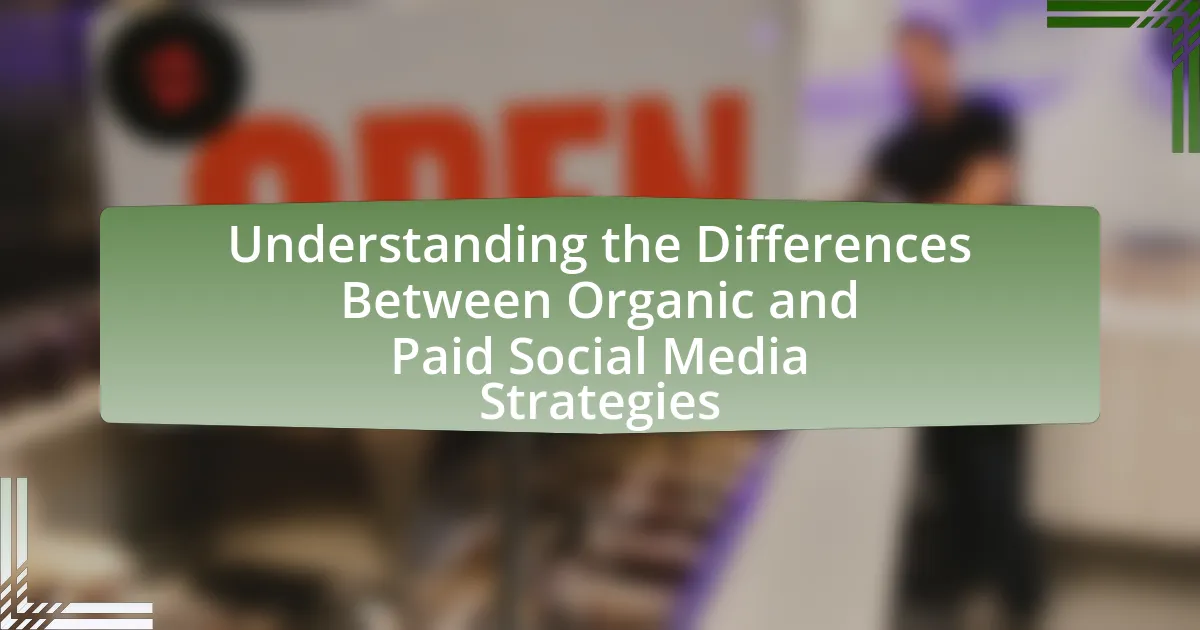A strong brand voice on social media is essential for establishing a recognizable identity that reflects a brand’s personality and values. This article outlines the significance of a consistent brand voice, detailing how it influences audience perception, fosters customer loyalty, and enhances brand recognition. Key elements defining a brand voice, such as tone, language, and personality, are discussed, along with strategies for developing and implementing a cohesive voice across various platforms. Additionally, the article highlights common pitfalls to avoid and practical tips for strengthening brand voice through storytelling and audience engagement.

What is a Strong Brand Voice on Social Media?
A strong brand voice on social media is a consistent and recognizable tone that reflects a brand’s personality and values across all communications. This voice engages the target audience, fosters brand loyalty, and differentiates the brand from competitors. For instance, brands like Wendy’s utilize a witty and playful tone, which resonates with their audience and enhances engagement, evidenced by their high interaction rates on Twitter. Consistency in this voice helps establish trust and familiarity, making it essential for effective social media marketing.
How does a brand voice influence social media presence?
A brand voice significantly influences social media presence by shaping how audiences perceive and engage with the brand. A consistent and authentic brand voice fosters trust and loyalty among followers, leading to higher engagement rates. For instance, brands with a clear voice can increase their social media interactions by up to 20%, as they resonate more effectively with their target audience. This alignment between brand voice and audience expectations enhances brand recognition and encourages user-generated content, further amplifying the brand’s reach and impact on social media platforms.
What are the key elements that define a brand voice?
The key elements that define a brand voice include tone, language, personality, and consistency. Tone refers to the emotional quality of the communication, which can range from formal to casual, influencing how the audience perceives the brand. Language encompasses the specific words and phrases used, reflecting the brand’s values and target audience. Personality represents the human traits attributed to the brand, such as being friendly, authoritative, or humorous, which helps create a relatable image. Consistency ensures that the brand voice remains uniform across all platforms and communications, reinforcing brand identity and recognition. These elements work together to create a cohesive and recognizable brand voice that resonates with the audience.
How can tone and language shape audience perception?
Tone and language significantly shape audience perception by influencing emotional responses and establishing brand identity. For instance, a friendly and conversational tone can create a sense of approachability, making the audience feel more connected to the brand. Conversely, a formal tone may convey professionalism and authority, which can enhance trustworthiness. Research indicates that 65% of consumers feel more positive about a brand when they receive personalized communication, highlighting the importance of tailored language in shaping perceptions. Additionally, consistent use of specific language styles can reinforce brand values, making them more recognizable and relatable to the audience.
Why is a consistent brand voice important?
A consistent brand voice is important because it fosters brand recognition and builds trust with the audience. When a brand maintains a uniform tone and style across all communications, it creates a cohesive identity that consumers can easily identify and relate to. Research indicates that brands with a consistent voice are 3 to 4 times more likely to experience brand loyalty, as consumers feel more connected to a brand that communicates in a familiar manner. This consistency not only enhances customer engagement but also reinforces the brand’s values and mission, making it easier for consumers to understand what the brand stands for.
What impact does consistency have on brand recognition?
Consistency significantly enhances brand recognition by creating a cohesive identity that consumers can easily identify and remember. When brands maintain uniform messaging, visuals, and tone across various platforms, they reinforce their presence in the minds of consumers. Research indicates that consistent branding can increase revenue by up to 23%, as it fosters trust and familiarity among the audience. This familiarity leads to higher recall rates and a stronger emotional connection, ultimately making the brand more recognizable in a crowded marketplace.
How does a strong brand voice foster customer loyalty?
A strong brand voice fosters customer loyalty by creating a consistent and relatable identity that resonates with consumers. When brands communicate in a clear and authentic manner, they build trust and emotional connections with their audience. Research indicates that 64% of consumers cite shared values as the primary reason they have a relationship with a brand, highlighting the importance of a cohesive voice that reflects those values. This consistency in messaging not only enhances recognition but also encourages repeat engagement, as customers feel understood and valued by the brand.

How can you develop a strong brand voice for social media?
To develop a strong brand voice for social media, define your brand’s personality and values clearly. This involves identifying the tone, language, and style that resonate with your target audience. For instance, a playful and casual tone may suit a lifestyle brand, while a professional and authoritative voice may be appropriate for a financial institution. Research shows that brands with a consistent voice across platforms can increase customer engagement by up to 33%, highlighting the importance of coherence in messaging. By aligning your content with your defined brand voice, you create a recognizable identity that fosters trust and loyalty among your audience.
What steps should you take to identify your brand’s voice?
To identify your brand’s voice, start by defining your target audience and understanding their preferences. This involves conducting market research to gather insights about their demographics, interests, and communication styles. Next, analyze your competitors to see how they communicate and differentiate your brand by establishing unique characteristics that resonate with your audience. Create a brand voice chart that outlines key attributes such as tone, language, and style, ensuring consistency across all platforms. Finally, test your brand voice through various content types and gather feedback to refine it further. This structured approach is supported by studies indicating that brands with a clear voice can enhance customer engagement and loyalty.
How can audience research inform your brand voice?
Audience research can inform your brand voice by providing insights into the preferences, values, and communication styles of your target demographic. Understanding these elements allows brands to tailor their messaging to resonate more effectively with their audience. For instance, a study by Nielsen found that 66% of consumers are more likely to purchase from brands that understand them, highlighting the importance of aligning brand voice with audience expectations. By analyzing audience feedback, social media interactions, and demographic data, brands can refine their tone, language, and content strategy to create a more authentic and engaging brand voice.
What role do brand values play in shaping your voice?
Brand values are fundamental in shaping your voice by providing a consistent framework that guides communication and engagement. These values define the principles and beliefs that a brand stands for, influencing tone, language, and messaging style. For instance, a brand that prioritizes sustainability will adopt a voice that emphasizes eco-friendliness and responsibility, resonating with like-minded audiences. This alignment not only fosters authenticity but also builds trust, as consumers are more likely to engage with brands that reflect their own values. Research indicates that 64% of consumers make purchasing decisions based on shared values, highlighting the importance of brand values in voice development.
How can you create guidelines for your brand voice?
To create guidelines for your brand voice, define your brand’s core values and personality traits. This foundational step ensures that all communication reflects the essence of your brand. Next, establish a tone that aligns with your target audience; for instance, a playful tone may resonate with younger demographics, while a professional tone may suit corporate clients. Additionally, create a vocabulary list that includes preferred terms and phrases, which helps maintain consistency across all platforms. Finally, document examples of both appropriate and inappropriate language to clarify expectations for your team. Research indicates that brands with clear voice guidelines experience 33% more engagement on social media, highlighting the importance of a cohesive brand voice.
What should be included in a brand voice guideline document?
A brand voice guideline document should include the following key components: tone, language style, vocabulary, audience persona, messaging pillars, and examples of dos and don’ts. Tone defines the emotional quality of communication, while language style specifies the formality or informality of the language used. Vocabulary outlines preferred terms and phrases that align with the brand identity. Audience persona describes the target demographic, ensuring that the voice resonates with them. Messaging pillars establish core themes that the brand consistently communicates. Lastly, examples of dos and don’ts provide clear guidance on acceptable and unacceptable expressions of the brand voice. These elements collectively ensure consistency and clarity in brand communication across social media platforms.
How can you ensure team alignment with the brand voice?
To ensure team alignment with the brand voice, establish clear guidelines that define the brand’s tone, language, and messaging. These guidelines should be documented in a brand voice style guide that outlines specific examples of how to communicate in alignment with the brand’s identity. Regular training sessions and workshops can reinforce these guidelines, ensuring that all team members understand and can effectively apply the brand voice in their communications. Additionally, implementing a feedback loop where team members can review each other’s work helps maintain consistency and adherence to the brand voice. Research indicates that companies with well-defined brand guidelines experience a 20% increase in employee engagement, which further supports alignment efforts.

What are effective strategies for implementing your brand voice on social media?
Effective strategies for implementing your brand voice on social media include creating a comprehensive brand voice guide, consistently using language and tone that reflects your brand’s personality, and engaging with your audience in a way that aligns with your values. A brand voice guide outlines key elements such as tone, vocabulary, and style, ensuring that all communications are cohesive. Consistent language and tone help reinforce brand identity, as seen in companies like Mailchimp, which uses a friendly and approachable tone across all platforms. Engaging authentically with your audience fosters trust and loyalty, as demonstrated by brands that respond to comments and messages in a manner consistent with their established voice.
How can you adapt your brand voice across different platforms?
To adapt your brand voice across different platforms, you must tailor your messaging to fit the unique characteristics and audience expectations of each platform. For instance, a professional tone may be suitable for LinkedIn, while a more casual and engaging voice works better on Instagram or TikTok. Research indicates that brands that align their voice with platform norms see higher engagement rates; for example, a study by Sprout Social found that 70% of consumers prefer brands that communicate in a relatable manner on social media. Therefore, understanding the demographics and user behavior on each platform is essential for effective voice adaptation.
What considerations should you make for platform-specific audiences?
When addressing platform-specific audiences, it is essential to tailor content to the unique characteristics and user behaviors of each platform. Different social media platforms attract distinct demographics and have varying content formats; for instance, Instagram emphasizes visual storytelling, while Twitter prioritizes concise text-based communication. Research indicates that 67% of users prefer brands that create content specifically for the platform they are using, highlighting the importance of customization. Additionally, understanding the platform’s algorithms and engagement patterns can significantly enhance visibility and interaction rates, as evidenced by studies showing that platform-optimized content can increase engagement by up to 50%.
How can you maintain brand voice while using various content formats?
To maintain brand voice while using various content formats, consistently apply your brand’s tone, language, and messaging across all platforms. This involves creating a style guide that outlines specific vocabulary, sentence structure, and emotional tone that reflect your brand identity. For example, if your brand voice is friendly and approachable, use conversational language and informal phrases in blog posts, social media updates, and videos. Research shows that brands with a consistent voice across different formats see a 20% increase in customer engagement, highlighting the importance of uniformity in communication.
What are common pitfalls to avoid when building a brand voice?
Common pitfalls to avoid when building a brand voice include inconsistency, lack of audience understanding, and failure to adapt. Inconsistency can confuse the audience and dilute brand identity; for example, a brand that shifts tone between formal and casual may lose credibility. Lack of audience understanding leads to misalignment with customer expectations, resulting in disengagement; brands must research their target demographics to tailor their voice effectively. Lastly, failure to adapt to changing trends or feedback can render a brand voice outdated, as seen with brands that do not evolve with social media dynamics, ultimately risking relevance in a competitive landscape.
How can inconsistency damage your brand’s reputation?
Inconsistency can significantly damage a brand’s reputation by eroding customer trust and loyalty. When a brand fails to maintain a consistent message, tone, or visual identity across its social media platforms, it confuses consumers and creates doubt about the brand’s reliability. For instance, a study by the Harvard Business Review found that brands with a consistent presentation across all platforms can increase revenue by up to 23%. This highlights that inconsistency not only affects perception but can also lead to tangible financial losses.
What are the risks of imitating other brands’ voices?
Imitating other brands’ voices poses significant risks, including loss of authenticity and potential legal repercussions. When a brand adopts the voice of another, it may alienate its audience, as consumers value originality and can detect inauthenticity, leading to diminished trust and loyalty. Furthermore, imitating a brand’s voice can infringe on intellectual property rights, resulting in legal challenges, as seen in cases where brands have faced lawsuits for trademark infringement due to similarities in branding and messaging. These factors underscore the importance of developing a unique brand voice that resonates with the target audience while avoiding the pitfalls associated with imitation.
What practical tips can help strengthen your brand voice on social media?
To strengthen your brand voice on social media, consistently define and adhere to a clear tone and style that reflects your brand’s identity. This involves creating a style guide that outlines language preferences, key messaging, and visual elements, ensuring all posts align with your brand’s values and personality. Research indicates that brands with a consistent voice can increase customer engagement by up to 33%, highlighting the importance of uniformity in communication. Additionally, actively engaging with your audience through personalized responses and user-generated content fosters a sense of community and reinforces your brand voice.
How can storytelling enhance your brand voice?
Storytelling enhances brand voice by creating emotional connections with the audience, making the brand more relatable and memorable. When brands share stories that resonate with their target audience, they foster loyalty and engagement, as evidenced by a study from the Harvard Business Review, which found that emotionally connected customers are more than twice as valuable as highly satisfied customers. This connection is achieved through narratives that reflect the brand’s values, mission, and customer experiences, allowing the audience to see themselves in the brand’s journey.
What role does audience engagement play in refining your brand voice?
Audience engagement is crucial in refining your brand voice as it provides direct feedback and insights into how your audience perceives your messaging. Engaging with your audience through comments, polls, and social media interactions allows brands to understand preferences, tone, and language that resonate most effectively. For instance, a study by Sprout Social found that 70% of consumers feel more connected to brands with a strong social media presence, indicating that active engagement can shape and enhance brand identity. This feedback loop enables brands to adjust their voice to align more closely with audience expectations, ultimately fostering loyalty and trust.




